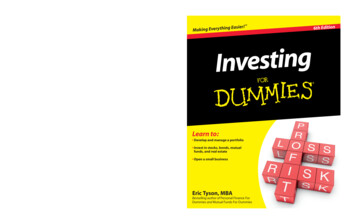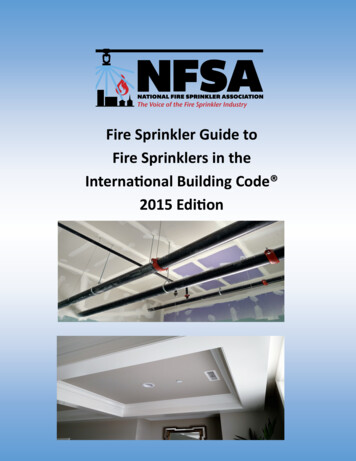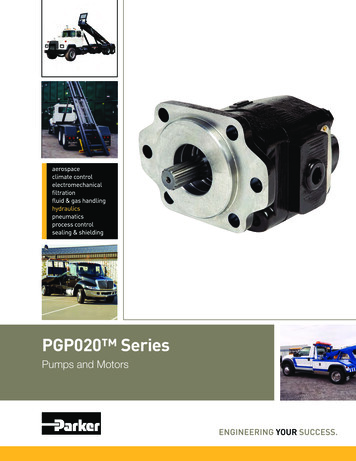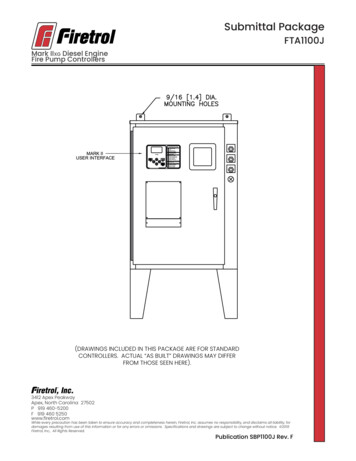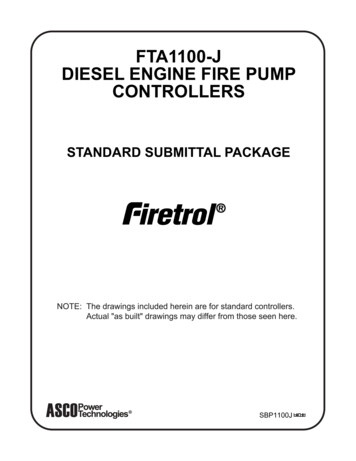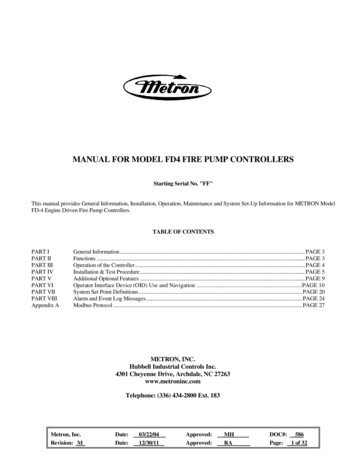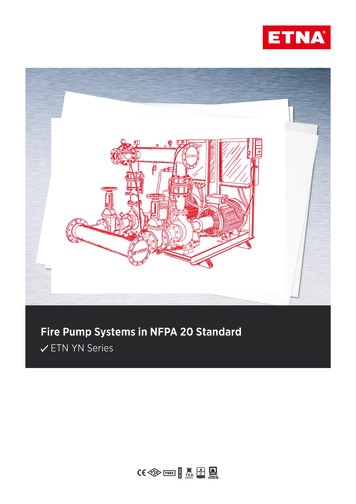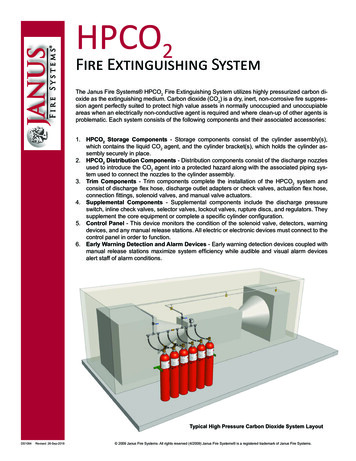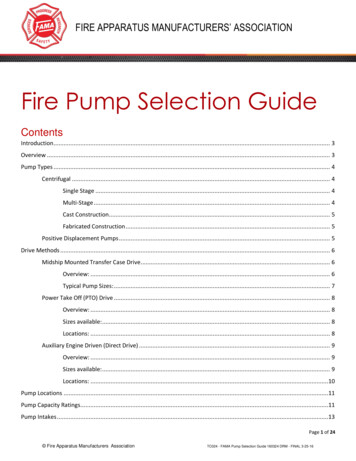
Transcription
FIRE APPARATUS MANUFACTURERS’ ASSOCIATIONFire Pump Selection GuideContentsIntroduction . 3Overview . 3Pump Types . 4Centrifugal . 4Single Stage . 4Multi-Stage . 4Cast Construction. 5Fabricated Construction . 5Positive Displacement Pumps . 5Drive Methods . 6Midship Mounted Transfer Case Drive . 6Overview: . 6Typical Pump Sizes: . 7Power Take Off (PTO) Drive . 8Overview: . 8Sizes available: . 8Locations: . 8Auxiliary Engine Driven (Direct Drive) . 9Overview: . 9Sizes available: . 9Locations: .10Pump Locations .11Pump Capacity Ratings.11Pump Intakes .13Page 1 of 24 Fire Apparatus Manufacturers’ AssociationTC024 - FAMA Pump Selection Guide 160324 DRM - FINAL 3-25-16
FIRE APPARATUS MANUFACTURERS’ ASSOCIATIONIntake Valve Types.13Internal (integral) intake valves .14External valves .14Pump Discharges .15Plumbing Size .15Valve Construction and Controls.16Valve Control Styles .16Discharge Instrumentation .17Chemical Injection .18Plumbing Material .18Hose and Appliance Connections .18Components .19Corrosion Prevention .20Annual Pump and Related Equipment Testing .20Appendix A - Abbreviations .21Appendix B – Pump Drive Mounting Diagrams .22Appendix C - Manufacturer Contacts .24Page 2 of 24 Fire Apparatus Manufacturers’ AssociationTC024 - FAMA Pump Selection Guide 160324 DRM - FINAL 3-25-16
FIRE APPARATUS MANUFACTURERS’ ASSOCIATIONIntroductionThis guide is intended to provide fire service personnel with information about the various types of pumps,their capacities, mounting locations on fire apparatus, drive systems, control and monitoring systems, andvalve types that are available for fire apparatus.As with any engineered system design, there are pros and cons to each configuration and not all arerepresented here. It is the responsibility of the purchaser to determine what best meets their needs and tospecify this information to prospective apparatus bidders, sellers, and manufacturers.As technology is continually evolving, this guide is presented as a general information and educationalpiece. The various options and auxiliary equipment presented may not be available from everymanufacturer, and some may be mutually exclusive.For more information, contact the FAMA Member pump, equipment, and apparatus manufacturers listedat www.fama.org.The National Fire Protection Association Standards define voluntary minimum standards for automotive fireapparatus. The two most widely used Standards are:NFPA 1901 , Standard for Automotive Fire ApparatusNFPA 1906 , Standard for Wildland Fire ApparatusThe current editions should be referenced when specifying new apparatus.www.nfpa.org.Within these Standards, pumps are divided into three main headings each with specific minimumperformance criteria:1.2.3.Fire Pump,Auxiliary Pump, andUltra-High Pressure (UHP) Pump.In Canada, ULC S515 Standard for Automobile Fire Fighting Apparatus is the accepted standard toreference.OverviewModern fire apparatus pump systems are comprised of many components utilized to move andcontrol water from a source. They use power to create or increase pressure to move the waterPage 3 of 24 Fire Apparatus Manufacturers’ AssociationTC024 - FAMA Pump Selection Guide 160324 DRM - FINAL 3-25-16
FIRE APPARATUS MANUFACTURERS’ ASSOCIATIONthrough piping and valves, then discharge the water to hose lines or other appliances to be directedto another location, applied to a fire, or other desired target.This guide will present in general terms:·······Pump TypesDrive MethodsPump LocationsPump Capacity RatingsIntake PlumbingDischarge PlumbingGovernor TypesPump TypesCENTRIFUGALCentrifugal pump design is the most typical for Fire Pumps and Auxiliary Pumps in modern fireapparatus and its proven design has been used in fire apparatus for well over a century. In a basiccentrifugal pump, typically a single casing, water enters through the pump inlet into the center (eye)of the impeller which is spinning on a shaft. Water is spun outwardly through the impeller vanes andinto a volute casing resulting in increased pressure. The water is then discharged at a higher pressurethan when it entered the pump inlet. Centrifugal pumps have the ability to draft (draw) water froman unpressurized water source with the aid of a primer. Centrifugal pumps are available as singlestage or multi-stage: such as two-stage and three-stage designs. Stages refer to the number ofimpeller(s) and water path(s) within the centrifugal pump.Single StageIn a basic Single Stage Pump, water enters through the pump inlet and into a single spinning impeller.Water then moves outward through the impeller vanes and into a volute casing. Pressure rises in thecasing resulting in a higher pressure out the pump discharge. A Single Stage Pump will not have aTransfer Valve.Multi-StageIn a Multi Stage Pump, there are two or more impellers that work together to provide the pump’srequired pressure and flow. Most designs have the impellers mounted on a single shaft, though,occasionally, they may be separate. (See “booster” pumps below)Page 4 of 24 Fire Apparatus Manufacturers’ AssociationTC024 - FAMA Pump Selection Guide 160324 DRM - FINAL 3-25-16
FIRE APPARATUS MANUFACTURERS’ ASSOCIATIONMulti-stage pumps are most typically used to develop high discharge pressures from 250 psi to 1500psi. Each impeller adds to the pressure it receives from the stage before it, typically providing outputpressures significantly higher than that of a single stage pump.Many multi-stage pumps, especially two-stage pumps, will be equipped with a transfer valve. Thetransfer valve allows the different stages of the pump to operate in either a pressure or volume mode.In the pressure mode, the stages are linked in series so that the output of the previous stage is routeddirectly to the subsequent stages, compounding the pressure as described above.In the volume mode, the stages are run in parallel so that the flow from each stage is basicallyadded together. Higher flows can be achieved.Some pumps may be equipped with a high-pressure “booster” pump. The booster pump impeller willlikely have its own casing separate from the casing for the other stages, though it may still be drivenoff a common gearbox. This pump may be plumbed in series with the other stage(s) for high pressureflow, or it may be plumbed as a stand-alone pump allowing simultaneous high and low pressure flow.A transfer case may be provided to switch between the modes.Cast ConstructionA single or two stage pump of cast construction typically has impeller inlet(s) and waterway(s) castinto one complete cast pump casing. The transfer valve on a two stage pump is located in an areaof the pump body where water can be controlled to either flow from one stage to another (pressuremode) or directly from each stage out the discharges (volume mode).Single stage and two stagepumps are available with iron or bronze castings.Fabricated ConstructionA single or two stage pump of fabricated construction will typically have a separate pump casingfrom the inlet and discharge piping. In the two stage pump, piping is used to connect one pumpstage to another and the transfer valve is in a location within the fabricated piping so water can becontrolled to either flow from one stage to another (pressure mode) or directly from each stage outthe discharge(s) (volume mode). Pump and apparatus manufacturers have the capability ofproviding stainless steel intake and discharge plumbing / piping on certain pumps.POSITIVE DISPLACEMENT PUMPSPositive Displacement Pumps are most often used for Ultra High Pressure pump applications. Apositive displacement pump is different from a centrifugal pump in that these pumps operate bydrawing water into a chamber then “squeezing” it out under pressure. Examples of positivePage 5 of 24 Fire Apparatus Manufacturers’ AssociationTC024 - FAMA Pump Selection Guide 160324 DRM - FINAL 3-25-16
FIRE APPARATUS MANUFACTURERS’ ASSOCIATIONdisplacement pumps used in the fire service are piston pumps, rotary vane pumps, and gear pumps.Each time the pump spins, a specific amount of water is moved. Because of this action, positivedisplacement pumps are capable of delivering constant flow at very high pressures at a constantspeed.Positive displacement pumps are restricted to low volumes (typically 50 gpm) due to size andcomplexity. They are most commonly used for
displacement pumps used in the fire service are piston pumps, rotary vane pumps, and gear pumps. Each time the pump spins, a specific amount of water is moved. Because of this action, positive displacement pumps are capable of delivering constant flow at very high pressures at a constant speed. Positive displacement pumps are restricted to low volumes (typically 50 gpm) due to size and .
